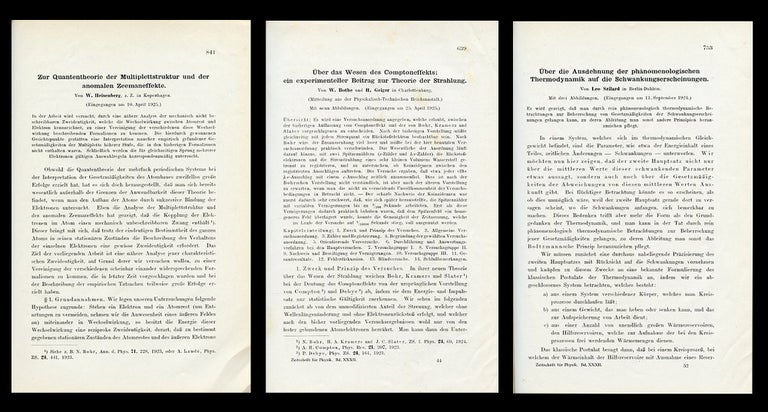Zur Quantentheorie der Multiplettstruktur und der anomalen Zeemaneffekte (Heisenberg, pp. 841-860) WITH Über das Wesen des Comptoneffekts, ein experimenteller Beitrag zur Theorie der Strahlung (Bothe & Geiger, pp. 639-663) WITH Über die Ausdehnung der phänomenologischen Thermodynamik auf die Schwankungserscheinungen (Slizard, pp. 753-788) WITH Zum Problem der Atherstrahlung in einer raumlich geschlossenen Welt (Lanczoz, pp. 135-149) in Zeitschrift für Physik, Vol. 32, 1925
Berlin: Julius Springer, 1925. 1st Edition. FULL VOLUME 1st EDITION OF A NUMBER OF IMPORTANT WORKS, AMONG THEM, ONE BY HEISENBERG ON THE COMPLEX SPECTRA OF MANY-ELECTRON ATOMS. Details on other significant works in this volume follow beneath the Heisenberg discussion.
In spring 1925, Heisenberg was convinced that what was needed was "a theory which abandoned the classical description of the electron orbits inside the atom and instead concerned itself with quantities that were accessible to observation" (RS Bio Memoirs, 220). On the heels of his work describing anomalous Zeeman effects and an early spring meeting in Copenhagen with Bohr, Kramers, and Pauli, Heisenberg received a letter from Pauli noting that while he [Pauli] still disagreed in principle with the Copenhagen radiation theory, he would probably come to terms with Heisenberg about the theory of complex structure" (Mehra, 200). Encouraged, Heisenberg began work on this paper, his third on quantum theory.
In it, Heisenberg provides a complete discussion of the issues including the various models of many-electron atoms used in his data -- the standard atomic core-series electron model, Pauli's model (wherein the electron was assigned four quantum numbers), and a model proposed by Russel and Saunders (an atomic core-series electron model).
Heisenberg begins "his treatment of complex spectra with the following hypothesis: 'If an electron and an atomic core interact… then the energy of this interaction possesses a reciprocal duplicity such that for given well-defined stationary states of the atomic core and the outer [series] electron there always exist two values of the interaction energy and therefore also two stationary states of the entire atom; inversely, to a given value of the interaction energy there always belong two systems of stationary states of the electron and the atomic core" (pp. 841-842). He then presents the "principal steps of the application of the correspondence principle to obtain the selection rules and the intensities of complex spectra" (Mehra 204). In so doing, he "fully exhausts the possibilities of the Copenhagen approach based upon the correspondence principle [and] succeeded in describing, at least in principle, all available data" (ibid).
WITH: Leo Slizard's "Über die Ausdehnung der phänomenologischen Thermodynamik auf die Schwankungserscheinungen" (pp. 753-788). von Neumann and Mandelbrot each noted the influence of this paper. In it, Slizard showed that fluctuations were consistent with and predicted from equilibrium thermodynamics and did not depend on atomistic theories, further showing how 'phenomenological' and 'statistical' thermodynamics can be made compatible. "Buried in this paper are many concepts, such as sufficiency, that anticipated mathematical statistics. The major result of the paper is that fluctuations can be included in a phenomenological formulation without any reference to a particular microscopic model" (Lavenda, Statistical, 218).
WITH: Bothe & Geiger's "Über das Wesen des Comptoneffekts, ein experimenteller Beitrag zur Theorie der Strahlung" (pp. 639-663). An important test of "conservation of energy and momentum during scattering was proposed and demonstrated shortly after the publication of BKS, (the Bohr-Kramers-Slater (BKS) theory was the final attempt at understanding the interaction of matter and electromagnetic radiation on the basis of the so-called old quantum theory" (History of Physics, Wenner Collection).
WITH: Lanczoz's "Zum Problem der Atherstrahlung in einer raumlich geschlossenen Welt" (pp. 135-149). Lanczos's first presentation of his "new approach to the problem of radiation by using the general theory of integral equations. With the new approach he could demonstrate the interaction between the world of atoms, which is only indirectly observable, and the observable and measurable world, the universe" (Gellai, Intrinsic, 36). Item #1009
CONDITION: 4to. Solidly bound blue buckram; gilt-lettered at the spine. Minor rubbing at the edge tips. Slight toning & wear within. Very good.
Price: $550.00

